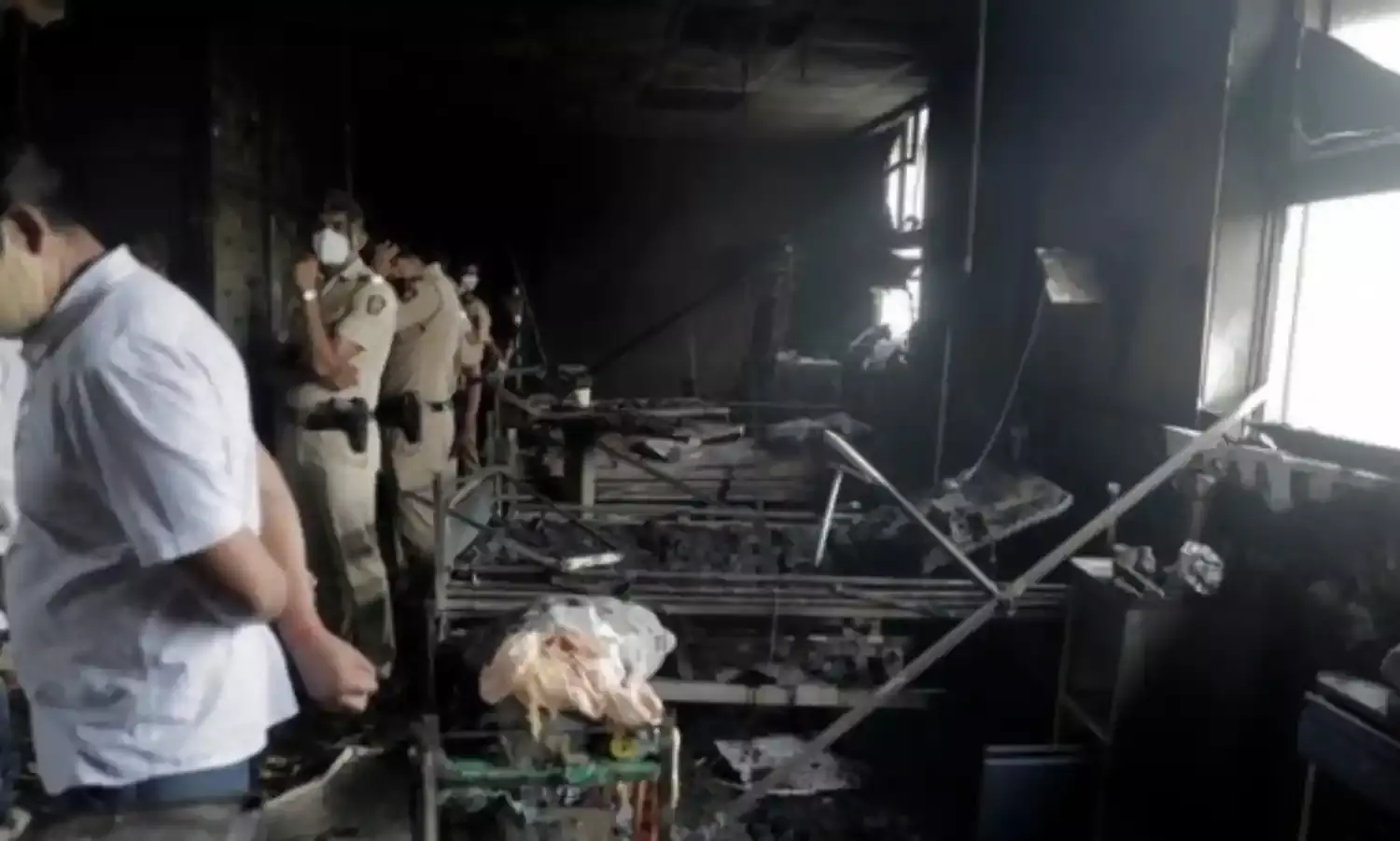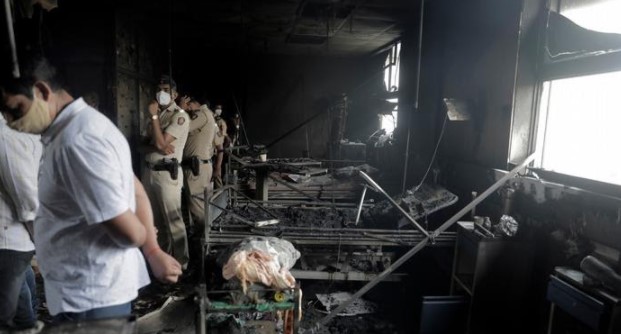Over 15 Hospital Fires Before 2021 is Out
Maintenance is a big issue

A fire on the third floor of the Kamla Nehru Hospital in Bhopal, has been the latest recorded incident, in a series of hospital fires all across India. The coronavirus pandemic brought to light a series of mismanagement issues at healthcare centres - and they have been facing the brunt of unexpected electrical loads, resulting in fires.
In a public tweet, Shivraj Singh Chouhan, Chief Minister, Madhya Pradesh, has called this incident ‘criminal negligence.’ The fire in Bhopal, got a lot of media attention since it involved the death of four children in the intensive care unit.
Hospital administrators have attributed this slew of fires to the rate at which hospitals were getting filled up during the first two waves of the pandemic. The infrastructure of these hospitals was not equipped to handle the inflow of patients, causing a pressure on the resources of these healthcare centres.
During this period, hospitals had become veritable fire hazards due to the overcrowding in COVID wards, increased demand for oxygen cylinders, alcohol based sanitisers and PPE kits which are flammable. Thus, hospitals become more prone to electrical short circuits turning into subsequent fires.
A report published by the National Center for Biotechnology Information, listed a few of the fires that occurred in the past few years, and the list is unfortunately long. It includes incidents at AIIMS, New Delhi, SAL Hospital, Ahmedabad, SMS Hospital, Jaipur, LNJP Hospital, Delhi, North Bengal Medical College and Hospital, Siliguri, Shine Children Hospital and Gandhi Hospital, both in Hyderabad, SSG Hospital, Vadodara (2019), ESIC Kamgar Hospital, Mumbai, Kakinada Government General Hospital, Andhra Pradesh (2018), RML Hospital, Farrukhabad, BRD Medical College, Gorakhpur (2017), SSKM Hospital, Kolkata, Medical College Hospital , Murshidabad, GTB Hospital, Delhi, Guntur Government Hospital, Guntur, and SUM Hospital, Bhubaneswar (2016).
The NCPCR earlier this week has also written to all secretaries of states and union territories, requesting a fire safety audit for all medical facilities for children.
“A hospital is a hospital,” Atul Garg, Chief Fire Officer of Delhi Fire Services said. He has been overseeing the fire audits in the healthcare facilities in Delhi. “So does this mean that hospitals that do not have a pediatric unit need not undergo audits?”
He explained, “All hospitals need to get an NOC (No Objection Certificate) from the Fire Department. This certificate is renewable after three years.” Speaking of whether or not the hospitals renew their certificates, he said, “This is the million dollar question.”
Garg told The Citizen that few hospitals got this certificate and few did not. “But you cannot shut them down, because see how many people they are treating?” He goes on to explain that there is a 20 point verification system during a fire inspection, to license a hospital with a certificate from the Fire Safety Department. Technically, if these 20 conditions are not met, the certificate cannot be issued. But often, these healthcare centres are given a pass if they fulfill eighteen out of the twenty, or a large majority of all of the prerequisites.
Of Delhi, he insisted that the national capital is in a much better state, as compared to the reports of hospital fires that have been occurring in states across India. “As far as Delhi is concerned, the situation is much much better. Almost all big hospitals have fire safety arrangements - water tank, hydrant, etc. - private hospitals also and government hospitals also.
Garg said that bringing about infrastructural changes in a healthcare facility is a long and time consuming process - one has to gather funds, submit plans, evacuate patients, etc. And so as and when the Fire Department makes suggestions, the Delhi hospitals gradually carry them out in their own time.
According to Garg, the reports of hospital fires have increased since the last couple of years due to all hospitals being overcrowded due to the pandemic. “You see, this is why most of the reports are of COVID wards catching fire,” he pointed out. “The ACs are continuously on, the machines are always on - there is a lot of pressure on the staff and the machines in hospitals."
The Delhi government ordered fire audits for city hospitals towards the end of October, following reports of a fire at a medical facility in Bhubaneswar, which caused 23 fatalities.
Rajendra Uchake, Chief Fire Officer at the Nagpur Municipal Corporation got to Well Treat Hospital in Wadi, forty-five minutes after the fire broke out. His team and the unit responsible for that area were already there when he arrived. Unfortunately, four patients in the ICU had already died by the time the fire was put out.
Uchake pointed out a few specificities to The Citizen that are behind the sudden slew of hospital mishaps in the country. “Actually the use of hand sanitisers has increased - especially in ICUs which is a confined space and you don’t really have any natural ventilation.”
He explained that most ICUs have window air conditioners or ceiling units. They do not have AHUs or (Air Handling Units). With the AHUs, there is a separate outlet for the used air to be expelled and another for the fresh air to be let in. In the case of window ACs however, the air is circulated in the same space, and the used air tends to rise up closer to the ceiling. “The vapour has no access to escape the room. So it gets accumulated near the ceiling.”
He said that ICUs are extremely oxygen rich environments, since almost all patients are attached to tanks - oxygen supports combustion and this makes these intensive care units imminent fire hazards. “If you place even a small diya in an oxygen rich environment, the diya will blow like a torch.”
“Patients who are on life support cannot be moved out. They do not have alternative ICUs for these people. There are fatalities in such cases.”
He made a concession for the evident unprepared situation our hospitals find themselves in, and pointed out that, “nobody could have anticipated that ICUs would be overcrowded in this way.”
Uchake said that the fire at Well Treat Hospital was caused due to a short circuit in the AC. Further investigation by the Wadi Police found that poor electrical wiring and inadequate safety equipment on the premises had caused the fire at the hospital. The Director Rahul Thavre has been booked by the police for causing four deaths due to negligence.
“Maintenance is a big issue,” Uchake told this reporter. “Everyone thinks that fire happens very rarely, so the maintenance part is ignored.”




